All you need to know about your products!

| 3DNews Vendor Reference English Resource - All you need to know about your products! |
||||||
 |
||||||
|
|
||||||
NVIDIA GeForce 6200 AGP (NV44A) RoundupAuthor:Date: 01/06/2005 Today, we are going on with reviewing video cards built on NV44A and presenting a roundup, benchmarking and research of the overclocking capability of three GeForce 6200 AGP video cards aimed at the low-end sector of the market. In the first part of the material, you'll be introduced solutions by Chaintech (the nonstandard modification - OC Version with the overstated GPU ), Leadtek, and XFX. Before the release of NV44A, the low-end sector of the AGP market looked somehow neglected. While varied PCI-E video cards were being promoted at an accelerated pace, the progress of the AGP sector was seen only in the middle-end where cards on the base of GeForce 6600GT and GeForce 6600 confidently took up their niches. A bit later, Canadians came up with their RX850XT (PE) and RX800 (XL) for the high-end sector and RX700 PRO for the mainstream. Meanwhile, in the low-end sector there were already cards which proved not morally outdated - that is, the previous-generation low-end and the former mainstream that turned cheaper were also thrown into the heap. Some hopes were built upon GeForce 6200 (NV43-V), but its price proved a bit too high the low-end positioning. Just see for yourselves - if the price difference between 6200 and the full-featured GeForce 6600 is $10-20, what sort of a sane user would need endless trouble with enabling the pipelines? It makes sense going into the trouble only if the price difference is more substantial. That is why the release of a new low-end solution with a price already acceptable for the sector looks quite a logical decision. It goes without saying that this turning cheap has reasons. The bus has been cut to 64Bit, with the slower memory installed, and the HSI bridge is not required - the card offers native support for the AGP. So, additional power is not required. Therefore, we have got solutions priced at about $60-70 (for the moment). Boards built on NV43-V will be gradually leaving the market - today GeForce 6600 can be easily made available at $110. In our today's roundup, apart from GeForce 6200A boards there took part NVIDIA's low-end of the previous generation solutions - GeForce FX5200 and 5500, as well as Radeon 9550 as a direct price competitors to GeForce 6200A by the Canadian company. Leadtek A6200TDH, XFX GeForce 6200, and Chaintech GeForce 6200 OC VersionLeadtek A6200TDH package bundle: 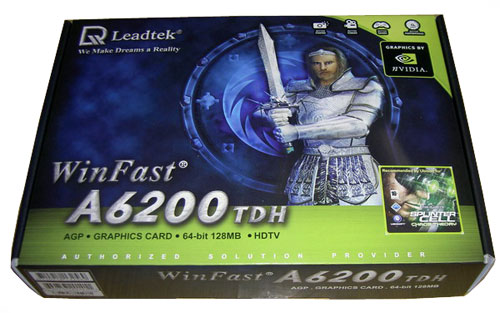
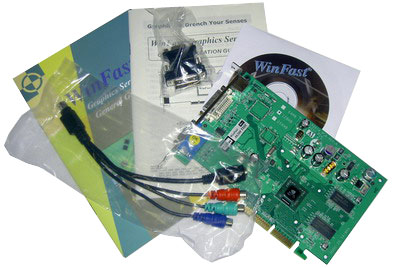 XFX GeForce 6200 package bundle: 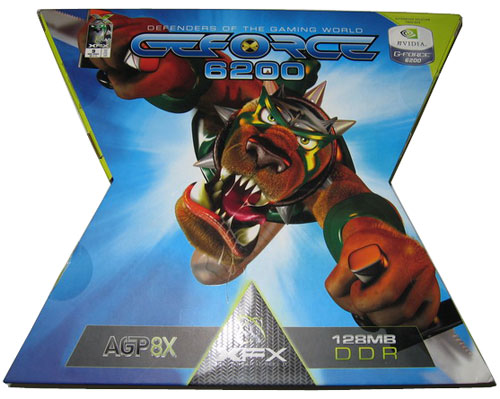
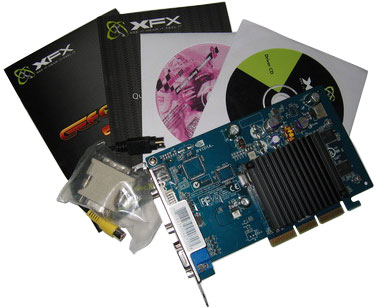 Chaintech GeForce 6200 OC Version package bundle: 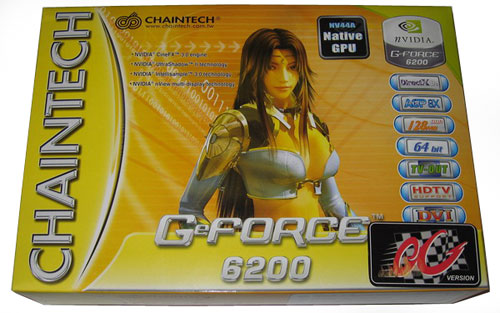
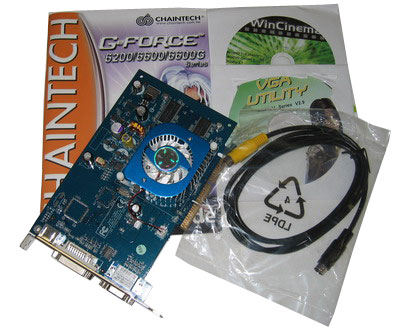 The PCB in GeForce built on NV44A has been simplified as compared to 6200 (NV43) - there is neither HSI bridge nor an additional power connector. The boards by Leadtek and XFX are also equipped with a passive cooling system in the form of an aluminum radiator on the GPU. The radiators are fastened with two clamps, and to prevent the board from damage upon contacts to the radiator protective spacers have been placed on its lower side. Chaintech's cooling system for GeForce 6200 is a regular fan on the GPU. Note that the manufacturer's web site presents data on a somehow different cooling system rather than that on GeForce 6200 of standard frequencies. But in this case it turns out that the card of overstated frequencies (which is indicated on the box as well) is equipped with a cooling system standard for GeForce 6200. As the thermo interface on Leadtek A6200 and Chaintech GeForce 6200, white thermo paste was used, and thermo sticker on XFX GeForce 6200. We were not able to remove it completely in the end, which is well seen on this photo: The card is equipped with 128 Mb of DDR memory with a 64-bit data transmission bus assembled of four memory chips in the TSOP package of 4 ns access time, which is equivalent to 500 MHz DDR at which the memory originally runs. The memory chips are positioned in two along each side of the PCB. Leadtek A6200 uses Hynix ICs 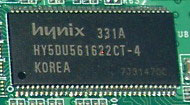 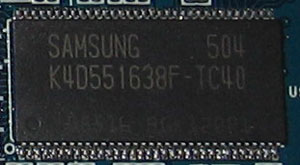 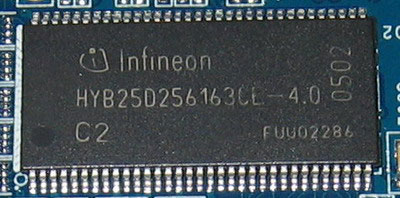 What makes boards built on NV44A different from NV43 significantly is the 64-bit bus. That has been made to push the price down, but it can't be a joy to the user. Apart from that, unlike 6200 based on NV43 and equipped with 3.6 ns (550MHz DDR) memory, the cards use much slower memory - of 4 ns access time. Let's look at the NV44A graphic processor in Leadtek A6200 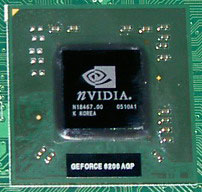 XFX GeForce 6200 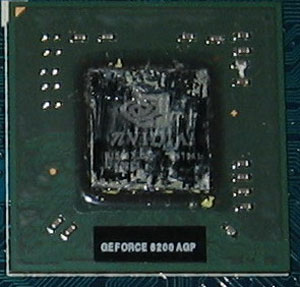 and Chaintech GeForce 6200 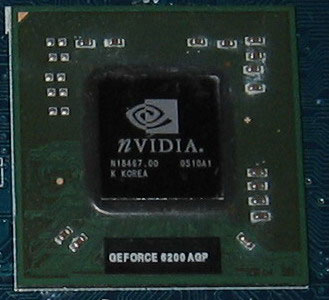 The nominal GPU operating frequency is 350 MHz, which is 50MHz greater than the standard GPU operating frequency for GeForce 6200 NV43-V. There are four pixel pipelines and three vertex units. Note once again, - that is a combination which can't be modified at all. Chaintech GeForce 6200 OC Version offers a GPU frequency (385 MHz) which is increased relative to other boards. All the boards are equipped with a standard set of outputs - analogous, digital, and TV-OUT. Now on to benchmarking. Test configuration
To test the ATI video cards, we used the latest Catalyst 5.4 WHQL-drivers, and ForceWare 76.44 beta drivers - for NVIDIA cards . 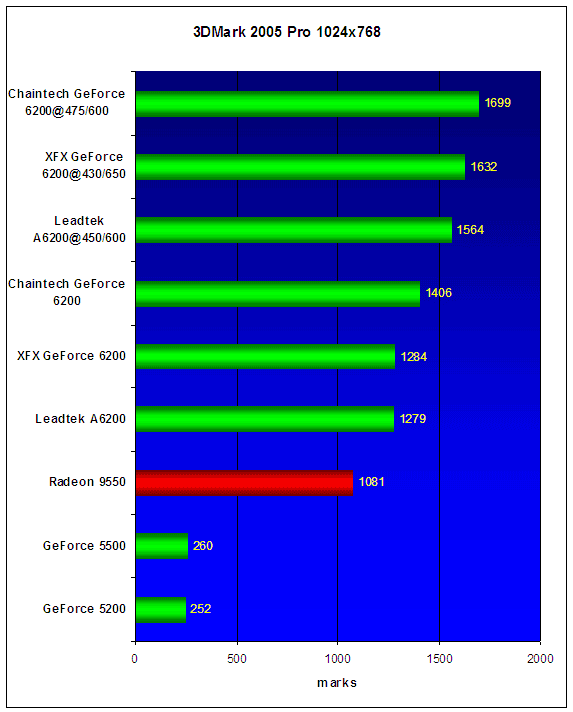 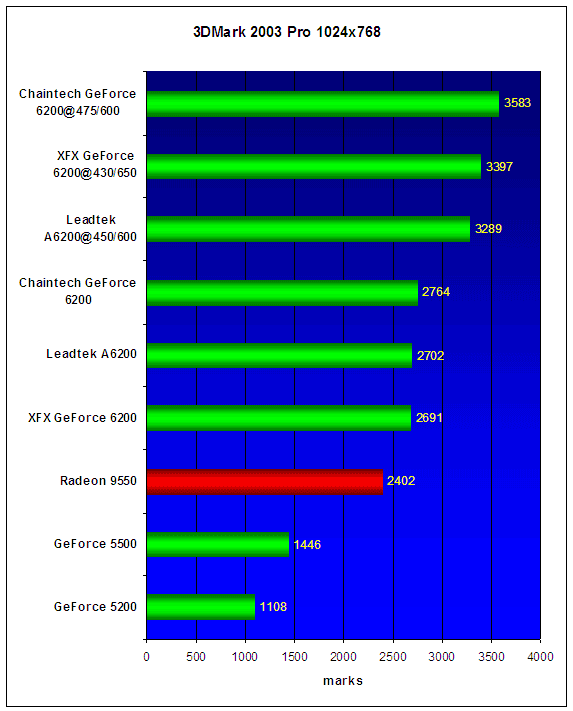 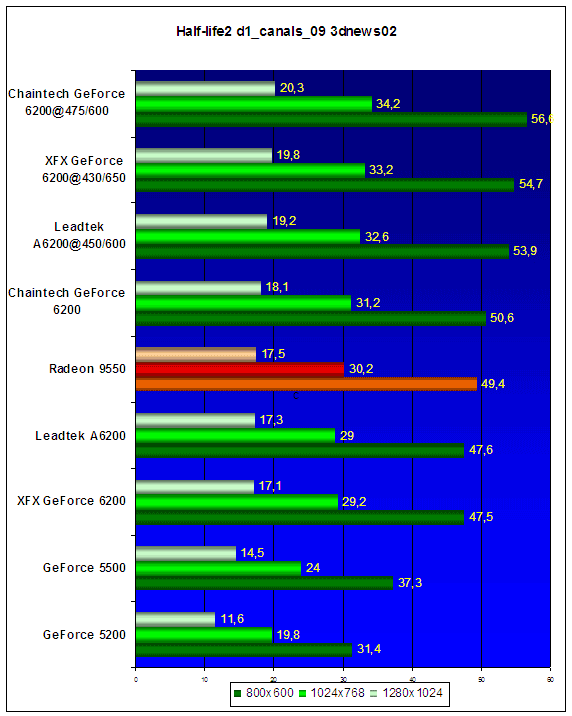 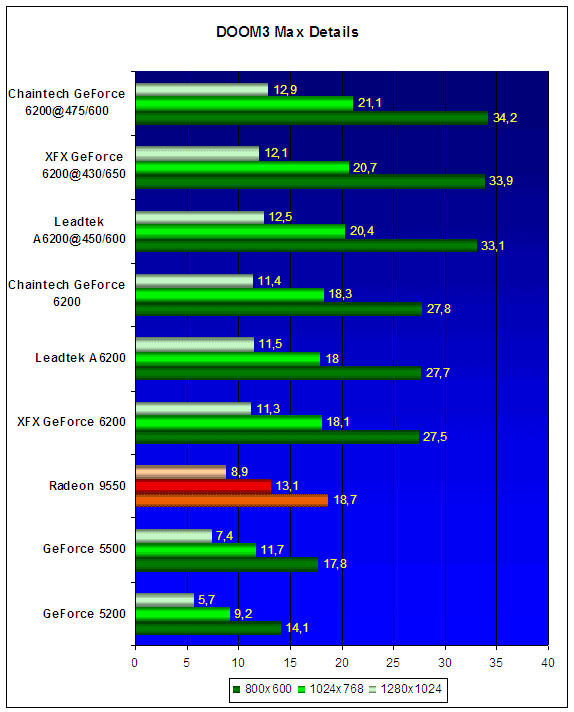 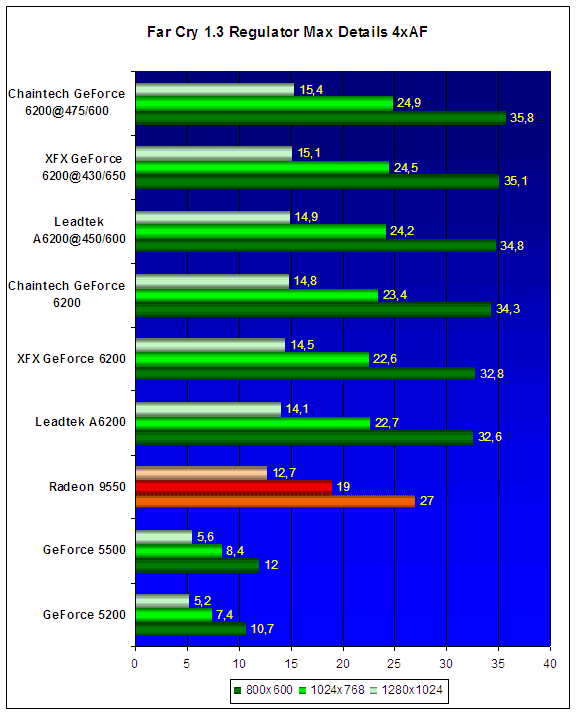 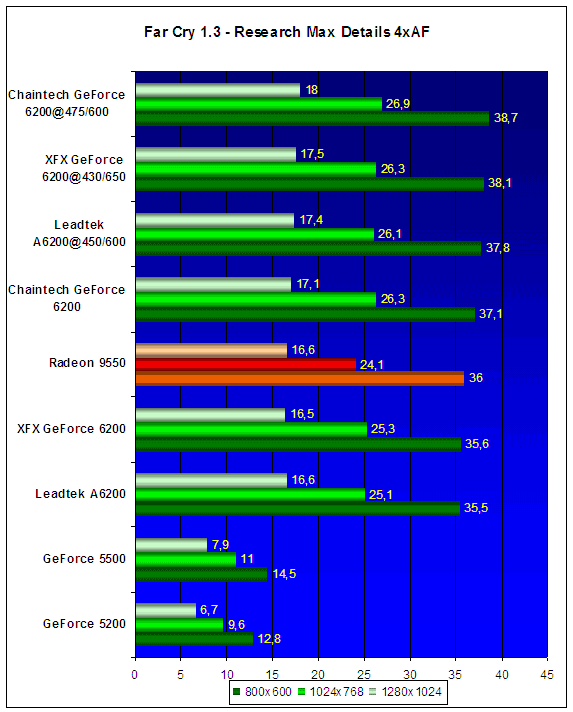 Performance and conclusionsPrior to getting round to a detailed debriefing for each of the cards reviewed today, let's draw up some conclusions on the performance of boards built on NV44A in general. 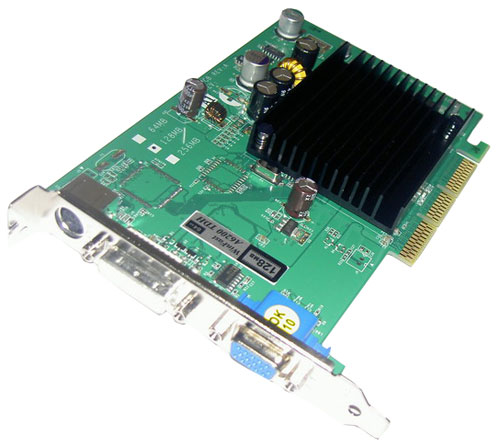 Compared to the low-end of the previous generation - GeForce 5200 (whose price is currently about $40 for the 128Mb make) and GeForce 5500 ($45-50) - all the boards built on NV44A definitely look more attractive. The 5200 and 5500 in most cases do not demonstrate an acceptable performance level even at 800х600, let alone much higher resolutions. Therefore, having replaced the not so successful FX series boards with more powerful GeForce 6 Series in other price sectors, NVIDIA has finally got round to the low-end where inexpensive 6200А boards with support for all the modern technologies including SM 3.0 and other "distinctive features" of GeForce 6 Series are meant to expel the ghost of previous-generation cards with all their shortcomings and thus are forced to leave the bright present day and the no less bright future. But the "bright present day" does not at all mean that such things like AA and AF as well as resolutions higher than 1024x768 will be accessible to you. To be more precise, all can be enabled but only in order to disable later and forget about it until you replace your video card with something more powerful (thus, more expensive). If you are currently short of finances, then be ready to face the performance which you will finally get. There is one thing which should make you happy - for its price, the product has proved superb and is many times superior over the low-end cards of the previous generation and even versus the relatively modern ATI's low-end Radeon 9550. So, owners of varied 5200, 5500 and 9200/9250 (including their endless number of modifications) have a very good chance to get an essential performance boost while staying on budget. All is simpler for those users who takes games as the priority. They won't be upset by the nervous breakdowns because of the "slide-show" in their favorite DOOM3. At the same time, they won't get AA and 1600x1200. Finally, they will be able to replace their GeForce 3/4/5 with a board built on NV44A and be quite pleased without extra costs. As regards the overclocking, the Chaintech's board proved to the best buy at that - we were able to overclock it from 385/500 MHz (standard for OC Version) to 475/600MHz. That is the best chip overclocking result of all the three specimens. The second honorable place is taken by XFX GeForce 6200 whose overclocking shortcoming is made up for by the memory overclocking - we were able to overclock it to 650MHz DDR, thus the boost proved to be 150MHz DDR. As regards Leadtek's GeForce 6200, we were able to overclock it to 450/600 MHz. Of course, these performance results can be improved through upgrading the cooling system or other modifications. But we are presenting results achieved with a standard cooling system. In conclusion, let me say that this material is only the first part of a review on NV44A boards shipped by various manufacturers. Due to various reasons, many very interesting video cards by industry leaders have not joined this article, including those by ASUS and Gigabyte. But we'll certainly fix that annoying neglect in the next part of GeForce 6200A Roundup. |
|
|||||